#moving image preservation of puget sound
Explore tagged Tumblr posts
Text
Tracking Seismic Clues in One of Driest Places on Earth - Technology Org
New Post has been published on https://thedigitalinsider.com/tracking-seismic-clues-in-one-of-driest-places-on-earth-technology-org/
Tracking Seismic Clues in One of Driest Places on Earth - Technology Org
Unlike the Pacific Northwest, the Atacama Desert in Chile experiences very little rain. But the two regions are both seismically active. Faults in the Atacama Desert are slowly sliding past each other, similar to the Seattle Fault in Puget Sound and the San Andreas Fault in California. The Atacama Desert’s lack of rain makes it easier to see how those gradual movements shape the landscape over time.
UW doctoral student Tamara Aránguiz-Rago collects rock samples on the hills next to a fault in Chile’s Atacama Desert for a pilot study in September 2022. This month she will collect more data to try to reconstruct the history of the formation of these mountains. Image credit: Emma Heitmann/University of Washington
Alison Duvall, a University of Washington associate professor of Earth and space sciences, and doctoral student Tamara Aránguiz-Rago will travel to Chile this month to study landscapes developed along these types of seismic faults. Duvall has previously studied historic landslides at the site of the rainfall-triggered Oso mudslide and how rainfall, earthquake and landslide risks combine in Oregon.
UW News asked the two geophysicists about their upcoming trip as part of a new series, “In the Field,” highlighting UW field research.
Where are you going, and when?
Tamara Aránguiz-Rago: We will visit the Salar Grande, in the hyper-arid, or dry, core of the Atacama Desert in Northern Chile. The Salar is a dry lakebed that contains economic resources, in the form of salt, that is extracted from the basin and then exported around the world. We’ll be there Nov. 19-25.
We’re interested in this area because it’s extremely dry and has active faults slicing through it. Only a few places on Earth register such low precipitation rates, offering a landscape that stores climate and tectonic variations from the past 50 million years. At our field site, some places haven’t seen a drop of rain in 500 years!
As a result, this is one of the best places on Earth to study how landscapes respond to earthquakes and plate tectonics under hyper-arid conditions. Dry conditions slow down erosion and help preserve landscape form and enable us to observe processes, like seismic tectonic processes, that modify the surface from deeper down.
The Atacama Desert in September 2022. The flat strip of land in the middle is not a human-built road but a strike-slip fault, where two blocks slowly slide past each other. Researchers will travel to the site again this month to learn more about these types of faults. Image credit: Tamara Aránguiz-Rago/University of Washington
Have you visited this field site before?
TA: I visited this site last fall with Emma Heitmann, another doctoral student in the Department of Earth & Space Sciences.
Alison Duvall: This will be my first time to this site, to Chile and to South America.
What do you hope to learn there?
AD: We want to learn more about the dynamics of slow faults that move laterally — strike-slip faults, similar to the San Andreas Fault in California — and how these dynamics control the shape of the landscape. In wet places, it’s hard to isolate faults’ effects on the landscape since water is the main agent driving erosion. What we observe on the surface in other places is a combination of tectonics and surface processes. However, thanks to the aridity of this place, it is easier to be confident about what is changing the landscape.
We’re also interested in how this landscape has shifted with a changing climate. This place was wetter in the past, and there is evidence of climate change happening to make the region hyper-arid. So we are also studying how the landscape has adapted to that change.
What’s something that you enjoy about this field work — especially something that might not occur to most people?
TA: There is a really special feeling when you’re in the driest place on Earth. It almost feels like you’re on a different planet. You don’t see any signs of life — no water, no animals, no plants — but it’s just amazing to feel that nothingness.
Changes in the landscape are so slow that when you visit the site, you know that each step you make, or any perturbation we make to collect our samples, can be one of the biggest modifications to the landscape in hundreds of years.
The Atacama Desert in September 2022. The flat strip of land in the middle is not a human-built road but a strike-slip fault, where two blocks slowly slide past each other. Researchers will travel to the site again this month to learn more about these types of faults. Image credit: Tamara Aránguiz-Rago/University of Washington
Anything you’d like to add?
AD: I’m super excited to get to this incredible field site and spend time with Tamara studying it. We have done field work together in New Zealand, and I have done decades’ worth of field work in many different geomorphic settings, but never in a hyper-arid landscape like this one. I can’t wait to see what we find!
Source: University of Washington
You can offer your link to a page which is relevant to the topic of this post.
#2022#amazing#America#amp#Animals#climate#climate change#data#dynamics#earth#earthquake#Earthquakes#economic#effects#form#Fundamental physics news#geophysics#History#how#human#it#Landscape#Learn#life#Link#mountains#News#One#oso#Other
0 notes
Text
Hannah Palin x MIPoPS!
Next in our series of profiles on the people who make MIPoPS tick, we’re talking to Hannah Palin, Moving Image Curator at the University of Washington Libraries’ Special Collections. Hannah is the life of the party. She has the je ne sais quoi usually associated with actors and celebrities - always two seconds away from putting on her next character, her next accent, her next story that’ll have you rolling on the floor with tears streaming down your cheeks. She is magnetic and magnanimus. She’s also on MIPoPS Board of Directors, AND directly responsible for much of the moving image preservation infrastructure here in Washington! Hannah has been with MIPoPS from the very beginning, and we are exceptionally lucky to have her.

Hannah at one of MIPoPS Moving History screenings at the Northwest Film Forum. Ari Lavigne (AL): HIYA! Who are you? What’s your av backstory? What do you do for work? Hannah Palin (HP): Hi back atcha! At one point in my evolution, I thought I decided to explore documentary filmmaking. I had some stories to tell and wanted to delve into film and audio production as a way to get my ideas out into the world. I needed a day job and found myself at a small company that transferred film to videotape. I spent five years sitting in the dark, watching home movies, educating our customers on what kind of film they had in their shoebox and how best to take care of it. In 2001, at the urging of a local filmmaker, I attended the Association of Moving Image Archivists conference in Portland and discovered that there was whole profession devoted to sitting in the dark, watching movies, and educating people on how to preserve their moving image materials. I met Nicolette Bromberg, Visual Materials Curator at the UW Libraries Special Collections, and she gave me her elevator pitch for starting a regional film archive. I was hooked. I started volunteering, then working on grant projects, then they finally gave me a job because I just wouldn’t go away. I’ve been working on building the moving image collections at the UW ever since. AL: How did you come to be involved with MIPoPS? HP: Rachel, MIPoPS Executive Director, and I met during the Washington Film Preservation Project in 2006. The UW was awarded a preservation grant from the Washington Secretary of State’s office to work with nine other institutions in the region to help them work on their film collections, including MOHAI, the Museum of Flight, the Yakama Nation, and Seattle Municipal Archives, among others. Rachel was working with Seattle Municipal Archives at the time, so we got to know each other a bit then. A few years later, we spent time at an Association of Moving Image Archivist conference in Savannah, which led to grabbing coffee back home, which led to conversations about creating a regional film archive, which eventually led to the birth of MIPoPS and the rest is Moving Image History. Because of my responsibilities at the UW, I’ve stepped into the role of Board Member, but I’d love to come back and play more soon! AL: You are a tremendously creative person. You’ve worked on both video and audio documentaries and even been featured on RadioLab - twice! If you had all the money and all the free time in the world, what creative projects might we find you tinkering away at?

Click here to listen to "The Day My Mother's Head Exploded", a 2004 piece by Hannah. HP: Good question! At this point, I feel like a lot of my creative juices are funneled into my job at the UW, but I’ve got another project that’s beginning to take shape. My biological father was a painter and I’ve become the caretaker of his collection, which includes 400 paintings and works on paper (https://www.kennethshowell.com/). I’d like to use my curatorial skills to get his work out into the public sphere, but I think there’s also a story in there somewhere that is just waiting to take shape. One of these days! AL: You’ve personally had a hand in training or otherwise fostering the development of most of the MIPoPS staff (Libby, Andrew Weaver, and I all worked with you at UW). How important is sharing your skill set with newbies in the field? Do you have a philosophy of mentorship / teaching / sharing? HP: I definitely feel an obligation to help the next generation of folks coming up because there just aren’t a lot of opportunities to learn about moving image preservation or archives in the Pacific Northwest. So, if you can’t get to NYU, UCLA, or Eastman House (which I couldn’t do either) come hang with me and I’ll tell you what I know. I learn as much from working with students as I hope they do from me. Every collection and project is so different that there’s always something new to figure out and to do. It’s a collaboration and I’m always thrilled when folks pick up the baton and move the profession forward. My mission is to preach the gospel of moving image preservation so that we can preserve the visual heritage of this region. When I started I could say that I was the only person in the state of Washington paid to work full-time on moving image collections. Now I’m thrilled to say that that isn’t the case. FIlm and videotape are being taken more seriously by cultural institutions across the state and there’s definitely a shift in thinking about them as primary source materials that deserve care and attention. AL: What areas do you think up and coming AV archivists should be exploring?

Hannah Palin and Libby Burke working on the winds at UW. Photo: Meryl Schenker, Seattle Post-Intelligencer, 2004. HP: Even though the digital revolution has pushed the field towards bits and bytes, I think that there is a need for everyone to be a jack-of-all-trades. Maybe it’s just me, but most of us are going to be Lone Arrangers, the sole voice of expertise in any organization, and you’ve got to be able to do it all. On any given day, I might meet with a donor, work with a student on their capstone project, repair a Umatic tape or clean a deck, meet with Advancement to discuss a grant opportunity, accession a new collection using ArchiveSpace, and use bagit to prep files for storage. You’re a specialist and a generalist all the time. It can be overwhelming, but it’s imperative to know it all. AL: What material have you seen lately that really moved you? HP: We recently acquired the KIRO-TV Channel 7 News library with 15,000 tapes from 1975-2006. Last month I discovered a 14 minute film from a program produced for KIRO’s first anniversary that aired in February 1959. It’s basically a day-in-the-life of a television news station and it shares with the audience how the broadcasters spend their days getting stories on the air. Like many TV stations across the county, KIRO discarded their 16mm film library when they switched to videotape in 1975, so this film is like finding a time capsule of what local news was like at the dawn of television. I’m thrilled that it turned up, I’m happy that we had the funds to be able to get a 2K scan at Light Press, and I’m ecstatic that I get to share it with students, researchers, and producers.
AL: Is there anything in your orbit that you’d like to share? It doesn’t have to be av related! HP: It is incredibly satisfying to see how far MIPoPS has come from its beginnings, how much it has grown because of the hard work that everyone has put into the organization (you, Libby, Andrew, and Rachel deserve kudos for all that you’ve done), and, most of all, how deep an impact it is having on our region. Amazing!!! Can’t wait to see what’s next!
#MIPOPS#moving image preservation#moving image preservation of puget sound#film studies#audiovisual archives#moving image history#film archivist#university of washington#seattle#pacific northwest#hannah palin#interview
0 notes
Text
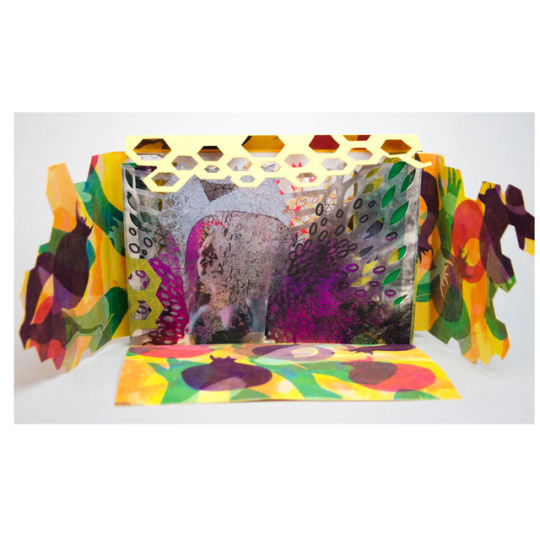
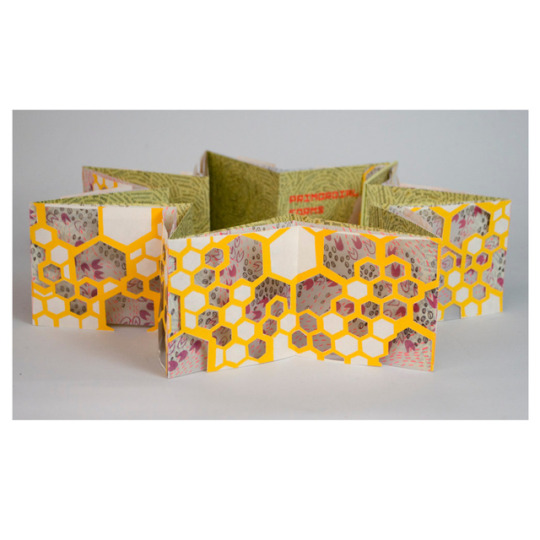

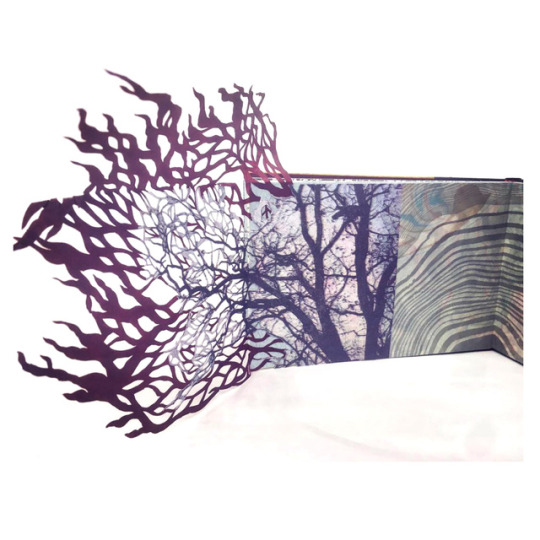
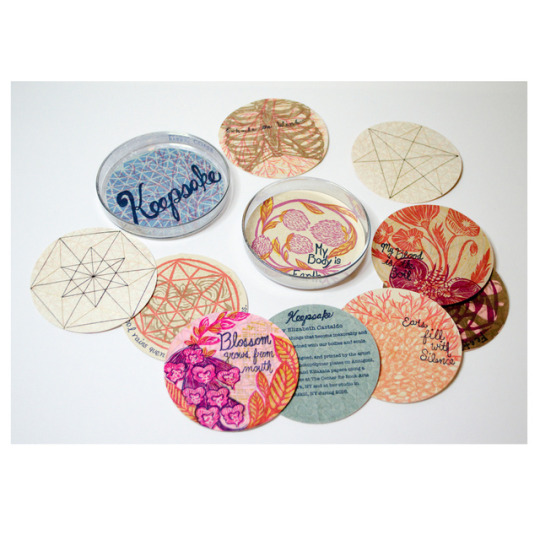
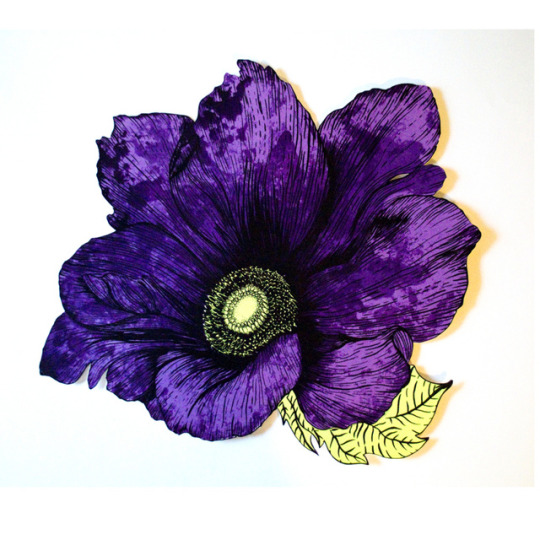
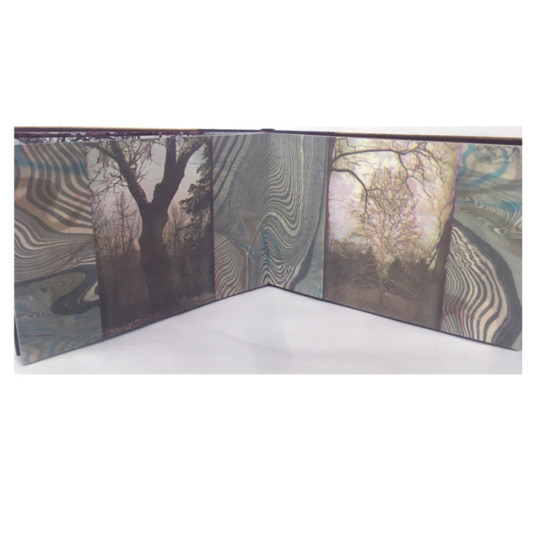

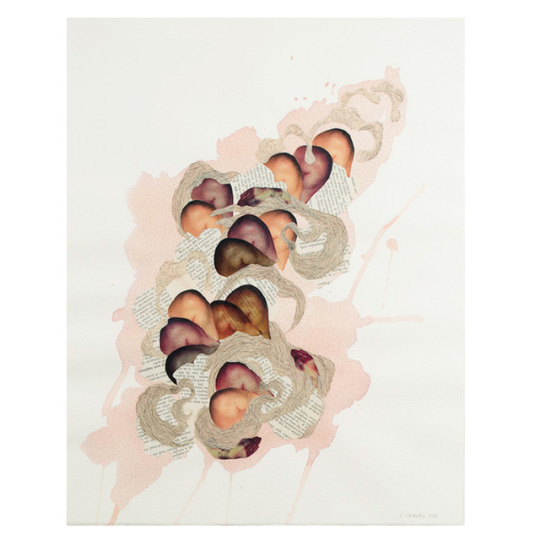
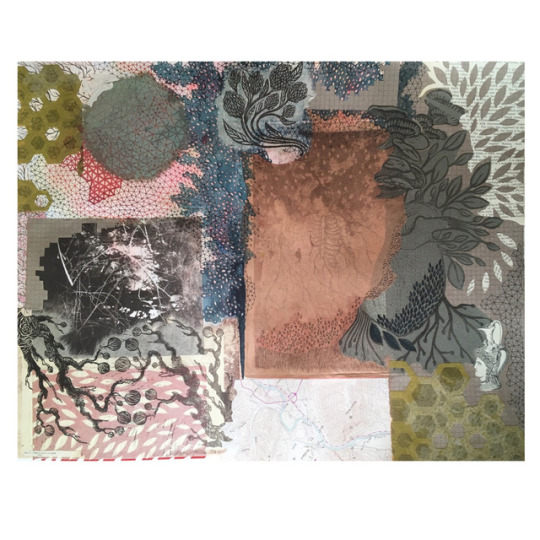
Next participant up for PrintCamp2019 Session 2/2:
ELIZABETH CASTALDO
ON HER WORK:
I work in mixed media, combining collage, drawing, and printmaking to create works on paper and artist’s books that explore the connection of feminine sensuality to nature and its manifestations in modern culture. I work with themes such at generation, growth, sexuality, entropy and decay. I am inspired by the structural patterns inherent in plant and animal life that reveal an undeniable connection between humans and the natural universe. My compositions become multi-layered worlds filled with motifs inspired by human anatomy, plant structures, and geometry. A key theme throughout the work is the resilience of living things and the ability for adaptation, despite a natural tendency toward disorder.
I recently wrapped up a yearlong residency at The Center For Book Arts where I focused on making artists books reflecting on my personal connection with nature as well as conservation, community and preservation of the natural world for future generations.
My work is process driven and each stage of the work is a reaction that is informed by the work that preceded. I work with pattern and layering, building up layers of hand drawn patterns, watercolor washes, original prints, collage, and appropriated imagery. Printmaking and multiples are central parts of my art practice and I am passionate about creating unique handmade art with a foundation in the practice and theory of printmaking. The layering involved in collage, printmaking and bookmaking provides the opportunity for concealment, excavation, and revelation.
WHAT SHE WILL BE DOING AT PRINTCAMP:
I hope to focus on experimenting with intaglio and lithography, figuring out how these techniques can fit within my studio practice. I would like to experiment with approaches to each process but ultimately move towards combining them with one another as well as other media. My goal for the week would be to come out with a small series of prints with a longer term goal of setting a foundation for making further work and more advanced use.
SKILLSHARE:
I would love to do a book making demo, perhaps a quick non-adhesive accordion or other quick structure that would be interesting to folks.
RESUME
Education
2013 MFA, Printmaking, Savannah College of Art and Design, Atlanta, GA
2007 BFA, Painting, School of Visual Arts, New York, NY
2012 SCAD Lacoste, Lacoste, France
RESIDENCIES AND NOTABLE WORKSHOPS
2017 - 2018 Scholarship for Advanced Studies in Book Arts, Center for Book Arts, New York, NY
2018 “Paper Memory” with Sarah Rose LeJeune, Women’s Studio Workshop, Rosendale NY
2018 Century Plate Lithograohy with Corinne Rhodes, EFARBPMW, New York NY
2017 “Experiments with Printmaking and Mixed Media” with Nandini Chirimar, EFA Robert Blackburn Printmaking Workshop, New York, NY
2017 “Full Tilt Bookbinding” with Susan Mills, Women’s Studio Workshop, Rosendale NY
2017 “The Working Artist” with Crista Cloutier
SOLO AND SMALL GROUP EXHIBITIONS
2019 New Book Art: Scholar Residents of 2018, Center for Book Arts, New York, NY
2018 Art That Binds, Atlantic Highlands Arts Council, Atlantic Highlands, NJ
2018 Some Assembly Required, Patchogue Arts Council, Patchogue, NY
2013 Solo Exhibition, Sensual Metamorphosis, MFA Thesis Exhibition
Dewberry Gallery, Atlanta, GA
2013 Pretty In Ink, Gallery Trois, Atlanta, GA and Pinnacle Gallery, Savannah, GA
2012 Freedom of Type, 2 Rules Gallery, Marietta, GA
2012 You Can’t Get There From Here, Emily Amy Gallery, Atlanta, GA
SELECTED GROUP EXHIBITIONS
2019 Freed Formats: The Book Reconsidered
2018 A Small Matter, Ann Street Gallery, Newbrugh, NY
2018 Windows on Main Street installation at A Lucky Cut, Beacon NY
2018 CBA Annual Benefit and Art Auction, Center for Book Arts, New York, NY
2018 Nassau Community College Art Faculty Exhibition, Plaza Art Gallery, Garden City, NY
2018 Exposed Strata, SGCI Conference, Las Vegas, NV
2017 EFA Robert Blackburn Printmaking Workshop Members Show NYNY
2017 SCAD Printmaking Alumni Exhibition, SCAD Atlanta, Atlanta, GA
2017 “Hello. I Love You. I’m Sorry,” SGCI Conference. Atlanta, GA
2017 Nasty Women, ABD Gallery, Philadelphia, PA
2016 Small Works Show, Catalyst Gallery, Beacon, NY
2015 RAW Montreal Holiday RAWK, Montreal, QC
2015 Traces, Howland Cultural Center, Beacon, NY
2013 - 2015 Monumental Ideas in Miniature Books III Traveling Exhibition, Exhibited at various institutions and conferences throughout the United States. Organized by Hui-chu Ying, Profesor of Art,
The Myers School of Art, University of Akron, Akron OH.
2015 A Show of Hands, The Hand Magazine at SGCI Knoxville, Southern Graphics Council
International Printmaking Conference, A1 Lab Arts, Knoxville, TN
2014 Narcissism and the Self Portrait, Ann Street Gallery, Newburgh, NY
2014 RAW Brooklyn presents: SCOPE, Brooklyn Night Bazaar, Brooklyn, NY
2014 Discordant, Mad Dooley Gallery, Beacon, NY
2013 ACA Library 6th Annual Student Artists’ Book Competition, ACA Library of SCAD, Atlanta, GA
2013 Georgia Artists: A Juried Art Exhibit, Abernathy Arts Center, Atlanta, GA
2013 Damn Fine!, Mason Murer Fine Art, Atlanta, GA
2013 Heart & Hands, 4th Annual National Student Juried Book Exhibition. University of Nebraska Lincoln Love Library, Lincoln, NB, and University of Nebraska Omaha Criss Library, Omaha, NB
2013 Qi, Sycamore Place Gallery, Decatur, GA and Cherrylion Studio, Atlanta, GA
2012 Exposition des Etudiants, SCAD Lacoste Campus, Lacoste, France
2012 Figuratively Speaking, Gutstein Gallery, Savannah, GA
2012 ACA Library 5th Annual Student Artists’ Book Competition, ACA Library of SCAD, Atlanta, GA
2012 In, On, Of Paper Juried Exhibition, Paper Circle, Nelsonville, OH
2012 Oso Bay North American Printmaking Juried Exhibition, Texas A&M University, Corpus Christie, TX
2011 The Student Exhibit, 2 Rules Gallery, Marietta, GA
2011 Illuminations Juried Exhibition, Center Arts Gallery, Newburgh, NY
2010 Wish You Were Here 9, AIR Gallery, Brooklyn, NY
2010 Images for a Godless World, Project Reach, New York, NY
2009 Think Gallery Affordable Art Series, Think Coffee Gallery, New York, NY
2008 The Print Show, Visual Arts Gallery, New York, NY
2007 Body Modifications, Visual Arts Gallery, New York, NY
2007 College Art Association Annual BFA Exhibition, Center for Art and Media Studies, New York, NY
2007 Tomorrow’s Artist Today, Visual Arts Gallery, New York, NY
2005 The Print Show, Visual Arts Gallery, New York, NY
HONORS AND AWARDS
2017 Scholarship for Advanced Studies in Book Arts, Center for Book Arts, New York, NY
2017 and 2018 Women’s Studio Workshop Summer Art Institute Scholarship Recipient
2017 SGCI Emerging Professional Grant Recipient
2013 First Place Purchase Award, ACA Library 6th Annual Student Artists’ Book Competition, ACA Library of SCAD, Atlanta, GA (Juror: Margot Ecke, Artist and Designer)
2012 Best In Show, Sidewalk Art Project, Atlanta Preservation Center Grant Mansion, Atlanta, GA
2012 SCAD Seen Gala Highlight Artist, Savannah College of Art and Design, Atlanta, GA
2012 Honorable Mention, ACA Library 5th Annual Student Artists’ Book Competition, ACA Library of SCAD, Atlanta, GA (Juror: Eileen Wallace, Artist and Bookmaker)
2011 Dean’s Fellowship in Printmaking, Savannah College of Art and Design, Atlanta, GA
2011 Second Place, Illuminations Juried Exhibition, Center Arts Gallery, Newburgh, NY
(Jurors: Stuart Sachs, Virginia Walsh, Martha Zola, and Peter Cody)
ARTIST TALKS
2019 Artist Talk for “New Book Art: Scholar Residents of 2018”, Center for Book Arts, New York, NY,
February 21, 2019
2018 and 2019 Visiting Artist, Muscota New School, New York, NY
2017 and 2018 Artist Talk on Book Arts for students of Professor Sondra Graff’s Bookmaking Class, Fashion Institute of Technology, New York, NY, November 29, 2017 and April 11, 2018
2015 Remote Artist Talk for students of Professor John Alfred’s Undergraduate Contemporary Art Classes, Savannah College of Art and Design, Atlanta, GA, April 28, 2015.
INSTITUTIONAL COLLECTIONS
University of Alberta, Bruce Peel Special Collections, Edmonton, Alberta
Bowdoin College, Special Collections Library, Brunswick, ME
Carnegie Mellon University, Hunt Library Special Collections, Pittsburgh, PA
Duke University, Perkins Library, Sally Bingham Center, Durham, NC
Lafayette College, Skillman Library Special Collections, Easton, PA
Massachusetts College of Art, Godine Library Special Collections, Boston, MA
Ringling College of Art and Design, Kimborough Library Special Collections, Sarasota, FL
Savannah College of Art and Design, ACA and Jen Libraries, and the Office of the President,
Savannah, GA, Atlanta, GA, and Lacoste, France
SUNY Orange Newburgh Department of Nursing, Newburgh, NY
University of California Santa Cruz, McHenry Library Special Collections, Santa Cruz, CA
University of Puget Sound, Collins Library, Special Collections, Tacoma, WA
University of Washington Libraries, Special Collections, Seattle, WA
University of Wisconsin, Green Bay, Lawton Gallery, Green Bay, WI
University of Wisconsin, Milwaukee, Library Special Collections, Milwaukee, WI
Yale University, Haas Library Artist Book Collection, New Haven, CT
PROFESSIONAL AFFILIATIONS AND MEMBERSHIPS
Vamp & Tamp Booksellers, Birmingham, AL
EFA Robert Blackburn Printmaking Workshop, New York, NY
Center for Book Arts, Artist Member, New York, NY
RAW: Natural Born Artists
Southern Graphics Council International, 2010- 2013, 2017
#printmaking#printmakers open forum#printcamp2019#elizabeth castaldo#printshopsanctuary#printcampsanctuary
6 notes
·
View notes
Text
0 notes
Text
0 notes
Text
0 notes
Text
0 notes
Text
More often than not we find ourselves visiting places we’ve been 10,000 times. We don’t live far from Port Townsend, Washington and that’s where a lot of our family is so we are there quite often. We love Port Townsend, as most Pacific Northwest residents do, and it’s our duty to share just why and what you can expect from a weekend in Port Townsend.
A quick note before we dive in: Port Townsend is also an amazing place to live. If you’re ever considering a change of pace or moving someplace because the people are weird and wonderful, that’s PT. Anyways…
History of Port Townsend
Port Townsend, Washington was founded in the 1800s and was intended to be the major city or seaport in the Puget Sound area. Well, that didn’t happen. Because everybody realized that they needed the railroad to connect with the rest of the West Coast, Port Townsend got built up and left to dry. It still was a great place to work on major sailing ships and to be a stop off before getting to Seattle, but it didn’t get developed into the major city that Seattle became.
The cool thing though about the failed attempt at creating a metropolitan area is that the town of Port Townsend has a really amazing Victorian downtown that’s really well preserved and then uptown is full of beautiful Victorian homes, several mansions, and a secondary neighborhood center that’s full of character and snippets of History.
Tip: if you’re super interested in the history of Port Townsend you can stop into the Jefferson County Historical Society in the old jail building. You can even do different Victorian tours throughout the year.
A Weekend in Port Townsend
Of course you don’t have to limit yourself to just a weekend in Port Townsend, but that’s definitely all you need to fall in love with the most charming Victorian seaport you’ve ever laid eyes on. For a longer stay, check out the different vacation rental options or even camping. But let’s get to it.
Fort Worden
We’ve written about Fort Worden State Park in Port Townsend several times. It’s an awesome place that we always go back to. Being the filming location for An Officer and a Gentleman, you’ll immediately recognize the vintage military housing, the bunkers and the beach.
Bunkers
The bunkers at Fort Worden are not for everybody. It’s easy to walk around them and imagine what they were like when they were in use 90 years ago, but going into the bunkers, into the dark… that’s not something everybody’s going to enjoy. Whenever we go to the bunkers at Fort Worden we’re sure to bring flashlights and to listen to what the kids want to do. It’s really dark and echoes a lot in the bunkers so be prepared for adults and children alike to get spooked. Really fun though.
Tip: If you’re interested check at the Fort Worden offices to see when bunker walks happen. Guided tours go off during the summer like clockwork and it’s a great way to learn about the history of Fort Worden in the whole area.
Point Wilson Lighthouse
You know our obsession with lighthouses. Obsessed. I don’t know why. But the Point Wilson Lighthouse at Fort Worden state park is really beautiful and is set in such a cool spot. Out on a point far away from the bluffs. The Point Wilson Lighthouse can be seen all across Puget Sound. Wonderfully white with the perfect red roof and outbuildings, it’s a great example of Pacific Northwest nautical architecture. During the summer you can check for when the lighthouse is open to actually go up into it. During the other seasons it’s very rare to have it open fully to the public unless there is a private educational event.
Walking out to the lighthouse is fairly easy and can be done by almost anybody. I can’t say for certain that it is fully wheelchair-accessible but some of the bunker areas close to the Point Wilson Lighthouse are and they do offer a wonderful view of the lighthouse.
Marine Science Center
We love taking the kids to the Port Townsend Marine Science Center. Focusing on the sea life found immediately in the waters below the dock it’s on, the Port Townsend Marine Science Center has LOTS of touch tanks and docents to teach kids (and adults) all about the Puget Sound.
In addition to the dock building, There is a second building across the street that has information about orca whales, the otter population of the area, and much more. This is a really hands-on museum experience. There are all kinds of bones, pelts, and games and activities to help kids learn about the marine life of the Puget Soun. It’s really fun.
Note: The Port Townsend Marine Science Center does have a fee separate of the Discover Pass fee for Washington State Parks. Whether you start on the dock or in the hands-on center, you can get a hand stamp and go between the two buildings.
Staying at Fort Worden
Once upon a time Chris got us a campsite at the Fort Worden campground just off the beach. Never in my life have I been so terrified that my tent was going to be picked up by the wind and that I’d be floating in the middle of Puget Sound. End of story.
Okay, it’s not always crazy windy like that, but camping at Point Wilson is going to put you on an unsheltered strip of land with the Puget Sound weather ready to mess with you. Just be prepared. You’ll find better camping at Old Fort Townsend State Park.
You can also stay in the awesome and newly renovated military housing at Fort Worden. The Officer’s Row houses can be rented out as can suites in the larger barrack buildings. The suites in the barracks are really large are perfect for a family of up to 12 probably. Lots of room with a full kitchen, dining area and living room, yeah, you’ll be fine bringing a nice group for a getaway to Fort Worden.
Tip: we always do our annual family reunion trip at Lake Cushman on the Olympic Peninsula, but Fort Worden is actually an ideal spot to get a large group together because of the variety of accommodations in all of the activities and open space to keep everybody having fun.
Downtown Port Townsend
We have family who lives in Port Townsend so we’re there often. We love walking around downtown just for the fun of walking around with all the cool Victorian architecture and the lively people. Oh the people. Port Townsend has a slogan: “we’re all here because we’re not all there.” It’s true. I love some of the wildness that you see happening on the streets of Port Townsend, from hipster accordion players to hippies who have been hippies since hippies were invented to the couple who’s become famous for living their lives in a fully Victorian fashion. Everybody is so unique.
Shameless plug: our aunt is an amazing barber in downtown Port Townsend. What’s more vintage that a stop into a really good barber shop? Check out Jim’s Barber Shop if you need to look sharp when you roll through town.
And the art! There are so many galleries and events for artists. One of the funniest events that happens in Port Townsend is the Kinetic Sculpture Race. It’s a race/competition/party where people have invented or designed sculptures that can move both on land and in water. They are always absolutely bizarre and not always do they float. It’s hilarious. The Saturday Farmers Market is also a great place to see and experience the art and local products of Port Townsend, and there are a lot of musicians too.
At the end of the downtown strip is Hudson Point where there is a marina and a handful of restaurants (Hudson Point Cafe is awesome!). Also the Northwest Maritime Center is at the end of the main drag downtown. The Maritime Center in partnership with the Wooden Boat Foundation (shared space and organization), is a really cool complex where people can learn about the vintage trade of wooden boat construction. It’s not just a hobby here, but a place that keeps the centuries-old skill and tradition alive. And if you want to build boats, the Center for Wooden Boats in Port Hadlock is the place.
Tip: The Maritime Center is another great place to rent out for events if you need to do set. This last summer we got to do Chris’s High School Union there. It was such a great space with the most beautiful view and it was perfect.
You know how I said that the people of Port Townsend are really interesting? They’re also very welcoming and exceptionally free spirits. Even though we know about the free spirits and general openness of Port Townsend, it took a day at Soak on the Sound to really feel it. Soak on the Sound has been happening at the end of downtown near The Maritime Center for a few years now. With both private and community saltwater soaking tubs it’s a really awesome place to go and relax. They also have licensed massage therapists available and tasty beverages (drinks to enjoy in your private soaking rooms).
Note: Soak on the Sound is clothing optional in the community saltwater tub and sauna area. When I say clothing optional what I mean is you don’t need to wear clothes because nobody is. It’s just a great place to go and really relax as nature intended. Nobody cares. Just be free.
Other highlights of downtown include Sirens Pub, which is upstairs in a cool old brick Victorian; Elevated Ice Cream, which is a vintage ice cream parlor who makes all their own flavors; Alchemy Bistro and Wine Bar, who makes an awesome steak served with blue cheese onion rings; and Abracadabra, the coolest toy store with more puppets than you can shake a stick at. There is, of course, so much more to do and eat, but these are just general suggestions.
Check out the vibe of downtown Port Townsend. It rocks!
Uptown Port Townsend
We don’t spend a ton of time in the Uptown area of Port Townsend but it is really cool. It’s the residential neighborhood full of Victorian homes and oodles of bed and breakfasts. It also has a nice, small shopping district whose restaurants are always busy. I think that’s why we don’t spend a lot of time in Uptown: it’s because the restaurants are always packed (because they’re really good).
Our favorite feature of Uptown Port Townsend is Chetzemoka Park. Situated at the north end of the Uptown District it is a truly Victorian park designed at the end of the 1800s. It has exactly what you would expect of any good park, meaning lots of open play space as well as two separate playgrounds, but then it also has a gazebo for weddings or hanging out in the shade, it’s got a cookout area and picnic tables, there is beach access if you’d like to walk down to the water, and then there is also a fantastic Victorian garden. Chetzemoka Park is a gem.
A lot of people who are in Uptown Port Townsend access it from downtown. They hike up the Haller Steps to access Uptown. Starting at the old Victorian Bell Tower and then wandering through all of the cool old houses is a great way to experience the genuine vintage feel of the entire town. And there are so many gardens. Oh yeah, and the deer population rivals that of the human population in the town.
Tip: For the easiest parking for anything in Port Townsend find street parking in uptown and go from there. You can easily walk down the Haller Steps into downtown, which is much better than trying to find parking downtown on a busy summer afternoon.
Getting out on the water
Our family loves boating. For us boating isn’t getting on somebody’s yacht and wearing our loafers and white shorts, but it’s just being on any boat on the water. Whether that means that you are taking a ferry into Port Townsend from Whidbey Island or you are doing any number of tours on the water, there are lots of ways to enjoy the maritime feel of the town.
Port Townsend does have several independent boat charters that you can do for a day if you want to go sailing or just troll around Puget Sound or up into the Strait of Juan de Fuca. And you cannot forget kayaking!
You can also go whale watching out of Port Townsend. The Puget Sound Express is a really fun family operated business with 30+ years of navigating the orca territory of the Pacific Northwest. This fall we did a special afternoon jaunt with Puget Sound Express just heading up to Protection Island for some bird watching. It was great having local, knowledgeable crew to guide the tour and hang out with on the sea. Perfect activity (even in cloudy, wet weather)!
We know that we are fortunate to live in the Pacific Northwest and Port Townsend is one of the most welcoming and fascinating places we have been, both locally and considering around the United States. True, we’re a bit biased because that’s where we have so much family and we know the town so well, but everybody that we take to Port Townsend falls in love with it immediately.
What do you think? Are you ready to plan a weekend trip to Port Townsend? If you want more recommendations or have any other questions don’t hesitate to ask. That’s what we’re here for!
A weekend in Port Townsend, Washington: Victorian charm meets the outdoors More often than not we find ourselves visiting places we’ve been 10,000 times. We don’t live far from Port Townsend, Washington and that’s where a lot of our family is so we are there quite often.
0 notes
Photo

A nonprofit battles the ‘magnetic media crisis’ by digitizing aging movies before they vanish
3 notes
·
View notes
Text
MIPoPS at the Nordic Museum
youtube

MIPoPS recently partnered with Seattle band postcard from the badlands to curate a selection of archival footage to be set to live music. The event, hosted at Seattle’s Nordic Museum, was an immersive experience of sound and visual storytelling.
From the promotional materials:
“Atmospheric music ensemble Postcard from the Badlands, in collaboration with Moving Image Preservation of Puget Sound (MIPoPS) and visual projectionist Torin Kovach presents: NAER VAER. The band performs their music composed exclusively for archival film footage curated by MIPoPS and for the Fjord Hall space itself, a first for this icy geologic space. Much of the footage comes from the Nordic Museum's archives as well as the UW and Seattle Municipal Archives and even old home videos. The montage and music, echoing narratives from the museum itself, represent themes of creation, community, conquest, migration, labor and play. Naer Vaer- Literally means "close dwelling" and metaphorically conveys a feeling of togetherness, presence, attendance, and deep connection with someone or something. The film footage and musical pieces likewise explore our deeper and often contradictory connections to each other and the natural world. Ravenna String Quartet will open the show performing modern and classical pieces from Nordic Composers and will be featured guests during the Postcard performance. Postcard from the Badlands: Christian Runge- Steel guitar, Guitar, Samples Vince Chan - Piano, Bass Ryan Burt - Drums, Percussion Schuyler Asplin - Trumpet Lauren McShane - Cello Torin Kovach - Projections and Film Editing MIPoPS Libby Hopfauf & Rachel Price- Archival Film Curation and Editing”



0 notes
Photo




Moving Image Preservation of Puget Sound and the Wing Luke Museum are beginning work on an exciting new project reformatting the videotapes in the Northwest Asian American Theatre Collection. The Northwest Asian American Theatre company was one of the earliest theater companies in the nation to highlight the work of Asian American actors and playwrights. From 1981 until 2004, this company was an important cultural center for the large population of Asian Americans who called Seattle home. This digitization project, funded by a grant from the National Historic Publications & Records Commission (a branch of the National Archives), will allow for the digitization of around 100 videotapes. These tapes include experimental dance, improvisational comedy, musical performances, and, of course, plays such as "And the Soul Shall Dance" (by Wakako Yamauchi), "F.O.B.", "Dance and the Railroad" (both by M. Butterfly playwright David Henry Hwang), and more. (M. Butterfly will be returning to Seattle January 24 - February 17th at ArtsWest!) Seattleite Roger W. Tang, considered by many to be the “Godfather” of Asian American theatre, explained the significance of this project as follows: “I am tremendously pleased that a valuable piece of our history and heritage has a chance to be preserved to be handed down to generations coming after us. In talking with younger artists across the country, I constantly am told that it’s too bad that a lot of our early work is not available. If there’s a fighting chance that this can get done, there’ll be a lot of excitement not just in Seattle, but across the country, as NWAAT was, for the longest times, one of just five Asian American theaters keeping the flame alive.”
Once completed, the majority of the collection will be available to the public on the Internet Archive. Segments from the collection will be shown at MIPoPS quarterly archival screening night, held at the Northwest Film Forum, on February 10th, from 5-6:30 pm.
0 notes
Text
MIPoPS receives another NEH award!

Moving Image Preservation of Puget Sound (MIPoPS) and RiceCapades are thrilled to announce that they are the recent recipients of a Research & Development grant from the National Endowment for the Humanities to fund their collaborative project DV Rescue!!!
This project will develop procedures and tools that will support migrating data from DV tapes into digital files suitable for long-term preservation. This will fill an urgent need for DV tape transfer tools that can rescue content from at-risk digital videotape formats. The DV Rescue project will entail two years of work to develop open source and freely available software, conduct user research and testing, and create documentation to help define and perform comprehensive, automated, and easy-to-use data migration techniques.
Specifically, MIPoPS and RiceCapades will:
Develop open source software to facilitate the most complete and accurate transfer of DV video from tapes to files, including video, audio, captioning, timecode, camera metadata, and preservation metadata.
Develop open source software to support improving DV files that have already been created by allowing such files to be assessed, so that the software may selectively retry portions of the tape and incorporate any improvements into the existing file.
Build a player to support visualization of uncorrected DV data, including categorizing DV transfer errors, illuminating when selective re-transfer may be most likely to offer improvements, and providing a method to easily distinguish authentic DV data, from error concealment techniques, and unconcealed damage.
Develop and pilot universal training materials and tools for ready deployment using a selection of partnering institutions as a test group.
Publish a white paper and present findings at significant preservation conferences throughout the United States.
The institutions selected for participation initially will include:
Carnegie Hall Archives (New York, NY)
New York Public Library (New York, NY)
Democracy Now! (Washington, D.C.)
Smithsonian – National Museum of African American History & Culture (Washington, D.C.)
Mid-Atlantic Regional Moving Image Archive (Baltimore, MD)
UCLA Library Preservation Program (Los Angeles, CA)
Living Computer Museum (Seattle, WA)
Seattle Municipal Archives (Seattle, WA)
Follow DV Rescue’s progress:
#dvrescue
Facebook & Instagram: @mipopsseattle
Twitter: @mipops_seattle
MIPoPS’ Blog: www.mipops.org
#digitalpreservation#audiovisualarchives#avarchives#archives#archivists#movingimage#preservation#dvrescue
0 notes